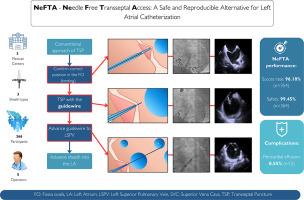Needle-free atrial transseptal access: A safe and reproducible alternative for left atrial catheterization
IF 2.5
Q2 CARDIAC & CARDIOVASCULAR SYSTEMS
引用次数: 0
Abstract
Background
Left atrial catheterization is a common procedure in electrophysiology labs to treat arrhythmogenic substrates on the left side of the heart. Needle transseptal puncture is the standard approach, but it can lead to complications related to device design or operator technique. To reduce these complications, needle-free alternatives have been explored.
Objective
This study aims to report the first multicenter application of the needle-free transseptal access (NeFTA) approach, assessing its safety and efficacy in patients undergoing electrophysiological procedures.
Methods
This retrospective, observational multicenter study evaluated the safety and efficacy of the NeFTA approach in patients undergoing ablation of left arrhythmogenic substrates across 3 electrophysiology centers in Mexico. NeFTA uses only a guidewire, without a needle or sharp guidewire. The sheath, with a dilator, is guided into the fossa ovalis under fluoroscopic guidance, using anterior force and clockwise torque to allow the guidewire to puncture the septum with minimal risk.
Results
The NeFTA technique was used in 366 patients. Most sheaths were deflectable, with nondeflectable sheaths in 43.4% of cases. Left atrial access via NeFTA was successful in 96.18% of cases, with pericardial effusion as the only complication (0.55% rate).
Conclusion
This technique was reproducible and safe, achieving successful access on the first or second attempt in 96.18% of cases, regardless of the operator.

无针心房经塞通道:安全、可重复的左心房导管检查替代方法
背景左心房导管术是电生理学实验室治疗心脏左侧致心律失常基质的常见手术。经脐穿刺留置针是标准方法,但它可能导致与设备设计或操作者技术有关的并发症。这项回顾性、观察性多中心研究评估了 NeFTA 方法在墨西哥 3 个电生理学中心接受左侧致心律失常基质消融术患者中的安全性和有效性。NeFTA 只使用一根导丝,没有针或锋利的导丝。带扩张器的鞘在透视引导下进入卵圆窝,利用前方的力量和顺时针方向的扭矩使导丝刺穿室间隔,并将风险降至最低。大多数鞘管是可偏转的,43.4%的病例使用不可偏转的鞘管。96.18%的病例通过NeFTA成功进入左心房,心包积液是唯一的并发症(发生率为0.55%)。结论该技术具有可重复性和安全性,96.18%的病例在第一次或第二次尝试时成功进入,与操作者无关。
本文章由计算机程序翻译,如有差异,请以英文原文为准。
求助全文
约1分钟内获得全文
求助全文
来源期刊

Heart Rhythm O2
Cardiology and Cardiovascular Medicine
CiteScore
3.30
自引率
0.00%
发文量
0
审稿时长
52 days
 求助内容:
求助内容: 应助结果提醒方式:
应助结果提醒方式:


